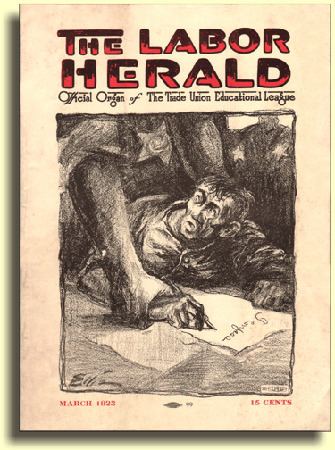 | ||
The Trade Union Educational League (TUEL) was established by William Z. Foster in 1920 as a means of uniting radicals within various trade unions for a common plan of action. The group was subsidized by the Communist International via the Workers (Communist) Party of America from 1922. The organization did not collect membership dues but instead ostensibly sought to both fund itself and to spread its ideas through the sale of pamphlets and circulation of a monthly magazine.
Contents
After several years of initial success, the group was marginalized by the unions of the American Federation of Labor, which objected to its strategy of "boring from within" existing unions in order to depose sitting union leaderships. In 1929 the organization was transformed into the Trade Union Unity League (TUUL), which sought to establish radical dual unions in competition with existing labor organizations.
Origins
The Trade Union Educational League (TUEL) was founded in Chicago in November 1920 by William Foster and a handful of close associates hailing from the radical movement. The group was very nearly stillborn, counting only about two dozen active members at its outset, including left wing Socialists, Communists, and former Wobblies. Shortly after the tiny group was called into being, Foster departed for Soviet Russia, ostensibly as a correspondent for the Federated Press news service, but actually to attend the Founding Congress of the Red International of Labor Unions (RILU), best known by its contracted Russian name, "Profintern."
The trip would prove to be important, as the former syndicalist Foster came to closely identify with the Bolshevik Revolution and its tactics.
After returning from Soviet Russia in 1921, quietly joined the underground Communist Party of America. He compiled his Russian journalism written for the Federated Press into a book called "The Russian Revolution" and set about touring the country lecturing on behalf of the Friends of Soviet Russia and acting as a fundraiser for Russian famine relief.
According to Foster's account, TUEL preexisted as an independent organization and "upon my return to the United States I had a meeting with the Central Executive Committee of the Communist Party, who agreed to support the work of the Trade Union Educational League." Foster stated that "the League is not an organic section of the Party but is simply endorsed by it."
Development
Foster's efforts to organize radical trade unionists through TUEL to remake the structure of the labor movement and to overthrow its existing leadership put him at odds with Samuel Gompers, head of the American Federation of Labor. Historians Peter J. Albert and Grace Palladino have summarized the situation in this manner:
"The forty-one year old [Foster] was everything Gompers was not. He embraced Communism and the Red International of Labor Unions, or Profintern (RILU), advocated independent working-class political action, and believed that the AFL would have to function as a strong, centralized organization if it hoped to survive and grow. Whereas Gompers presumed that the great mass of workers would learn the value of solidarity through direct experience, Foster and his supporters favored a more top-down approach.... With amalgamation as its slogan, industrial unionism as its goal, and 'boring from within' the established trade unions as its method, the TUEL promised to transform otherwise 'timid and muddled' AFL affiliates into 'scientifically constructed, class conscious weapons in the revolutionary struggle.'"
In defending the existing system from what he perceived as a Moscow-directed attack, Gompers availed himself of every opportunity to question Foster's motives and emphasize his close personal connection with the American Communist movement.
Structure
The TUEL did not have formal membership rolls or paid dues. No membership cards were issued. The organization instead supported itself through sales of pamphlets and magazines and through an unpublicized subsidy by the Communist International by way of the Workers (Communist) Party.
Consequently, the size of the de facto membership of the organization is difficult to gauge. Historian Ralph Darlington notes that while TUEL declared a circulation for its publications of from 10,000 to 15,000, in actual fact the group only had "about 500 hard-core activists" at the time of its greatest strength during the first years of the 1920s.
Transformation of the organization
In 1928, as a byproduct of the Third Period ultra-radicalism of the Communist International, the TUEL was transformed into the Trade Union Unity League (TUUL), a federation of industrial unions established in opposition to the American Federation of Labor craft labor unions. Even though this change of tactics met a refutation of William Z. Foster's long-held strategy of "boring from within" the existing trade unions, in favor of "dual unionism," Foster nevertheless continued to remain loyal to the new TUUL organization.
